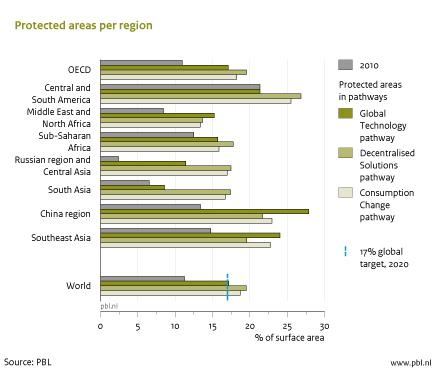Roads from Rio+20
This report analyses how combinations of technological measures and changes in consumption patterns could contribute to achieving a set of sustainability objectives, taking into account the interlinkages between them. The potential exists for achieving all of the objectives.
The fundamental question, however, relates to the types of governance structures that could bring about the transformative changes required to achieve the sustainable development objectives. We suggest a pragmatic governance approach that consists of a shared vision for 2050, strengthened short-term targets, and strong policy actions by governments, building on the strength of civil society and business.
Without new policies, goals will not be achieved
In 1992, in Rio de Janeiro, governments worldwide agreed to work towards a more sustainable development that would eradicate poverty, halt climate change and conserve ecosystems. Although progress has been made in some areas, actions have not been able to bend the trend in other, critical areas of sustainable development – areas such as those providing access to sufficient food and modern forms of energy, preventing dangerous climate change, conserving biodiversity and controlling air pollution. Without additional effort, these sustainability objectives also will not be achieved by 2050.
The potential exists to achieve sustainable development goals
There are alternative pathways along which the sustainable development goals could be achieved, but all require transformative changes. This study analyses effort levels and measures required to achieve a set of sustainable development goals. These goals are derived from existing international agreements (e.g. the Millennium Development Goals, UNFCCC and UNCBD).
Eradicating hunger and maintaining a stable and sufficient food supply while conserving biodiversity
In order to feed a growing and overall wealthier population, food production needs to increase by around 60% during the 2010–2050 period. The expected slowdown in agricultural productivity increase, the growing demand for bio-energy and wood products, as well as climate change, could result in increasing competition over land, and related impacts on biodiversity and food supply. Options to prevent this include land-use policies, dietary changes, reducing losses and faster yield increases. To achieve long-term goals, four fundamental short-term policy priorities can be defined: 1) create conditions to accelerate sustainable agricultural intensification, 2) ensure a more robust food system to reduce hunger, 3) mainstream biodiversity considerations in land-use planning and management, and 4) promote changes in consumption patterns. Clearly, these priorities are likely to differ across countries, depending on income levels.

Under the 'Global Technology' pathway the most important contribution by far comes from increasing agricultural productivity on highly productive lands. Under the 'Consumption Change' pathway, significant reduction in the consumption of meat and eggs as well as reduced wastage means that less agricultural production would be required, thus, reducing the associated biodiversity loss. Under the 'Decentralised Solutions' pathway, a major contribution would come from avoided fragmentation, more ecological farming and reduced infrastructure expansion.
Ensuring access to modern energy sources for all, while limiting global climate change and air pollution
As is the case for food, energy production also is expected to increase by around 60% over the next four decades, and access to modern energy needs to be improved. At the same time, however, greenhouse gas emissions would need to be halved in order to achieve the 2 °C target to limit climate change. Several options are available to achieve this, including efficiency improvement, use of renewable energy and carbon capture and storage. To meet the long-term goals, four fundamental short-term policy priorities can be defined: 1) substantially increasing efforts to ensure modern energy for all; 2) peaking global greenhouse gas emissions around 2020; 3) introducing appropriate pricing instruments; and 4) ensuring sufficient financing and reform of international climate policy, including R&D efforts. Priorities in these areas are dependent on income level.
A more effective approach to sustainable development is needed
As indicated above, the technical potential exists to achieve the long-term goals. The crucial question is how to implement these measures. Current policies are not enough and international negotiations seem to make only slow progress. Adaptations to the current approach may consist of an increased focus on creating a reliable long-term vision, combined with stimulating learning and innovation. Incentive structures should match these long-term goals. Such an approach could be based on the following key elements:
- Develop a consistent vision with long-term goals and short-term targets, integrating various areas of sustainable development;
- Ensure that the rules and regulations which govern day-to-day decision-making are adapted to create the right incentive structure for transformative changes;
- Increase coherency for relevant decision-making processes;
- Reform policy-making at an international level, based on three complementary strategies.
- Linkto the Roads from Rio+20-website (archived)
- Linkall video's from 'Roads from Rio+20'
- Linkto the IMAGE website
- Nieuws | 15 May 2012Roads from Rio+20: pathways to achieve global sustainability goals by 2050
- Nieuws | 30 May 2012'Rio as World Exhibition', spoken column at 'Rio aan de Maas' festival in Rotterdam
Authors
Specifications
- Publication title
- Roads from Rio+20, pathways to achieve global sustainability goals by 2050
- Publication date
- 15 May 2012
- Publication type
- Publication
- Publication language
- English
- Product number
- 626




